Drones involved in SEVEN near-accidents with aircraft in the North East, investigation shows
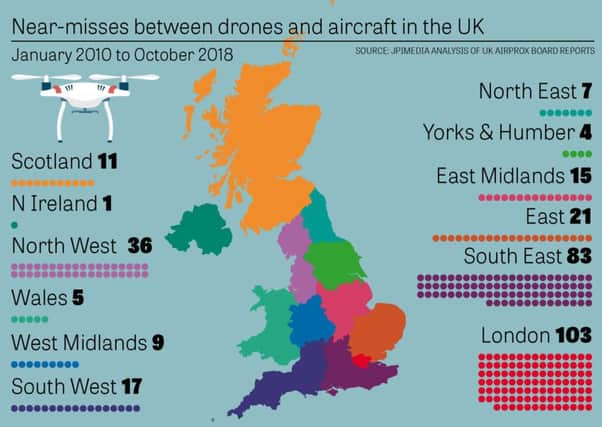

There were more than 300 near-misses between drones and aircraft across the UK, even before the major disruption seen at Gatwick and Heathrow this winter.
This includes the seven near-accidents in the North East, which is served by Newcastle International and Durham Tees Valley Airports, as well as a number of smaller club and private airfields.
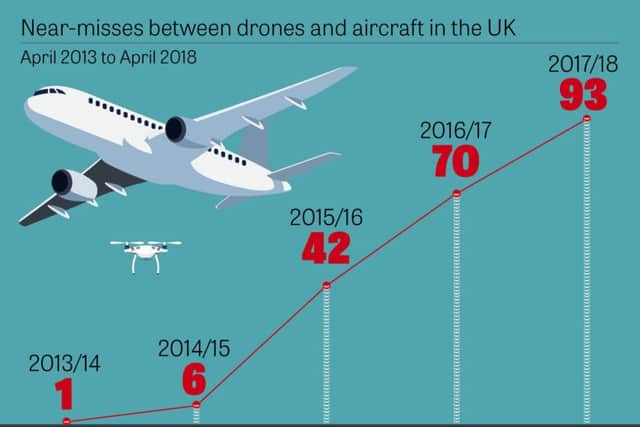

Advertisement
Hide AdAdvertisement
Hide AdOf the other incidents, three took place in the skies above Tyne & Wear and two in County Durham.
In the most serious incident – listed as a category A serious incident – the pilot of a Cessna 404 twin-engined light aircraft flying near Bolam Lake reported a drone missing his wing tip by just six to eight feet.
The pilot reported that he was travelling north when he saw a large blue object slightly to the left of his aircraft’s nose at exactly the same level.
He was startled and it took him a few seconds to realise that it was a drone.
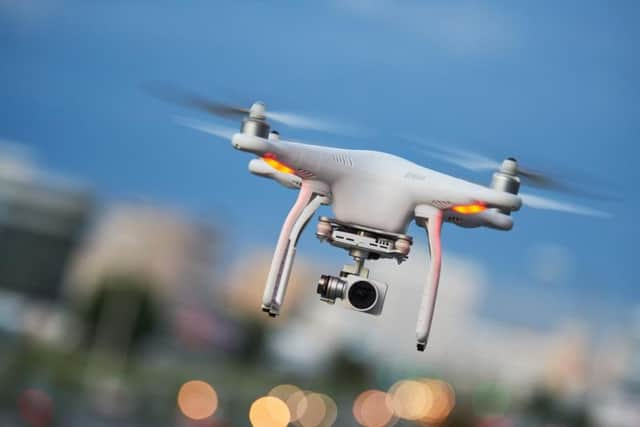

Advertisement
Hide AdAdvertisement
Hide AdHe had no time to react and the drone passed down his left-hand side, missing the wing tip by about six to eight feet.
Although the incident, which happened on July 18, 2017, only lasted for five or six seconds, the pilot estimated that the drone was one metre long and half a metre wide. It was dark blue and either stationary or slow moving.
Members of the Airprox Board, which examines incidents and looks to approve safety, said the drone was being flown beyond practical visual line of sight (VLOS) limits and was endangering other aircraft at that location and altitude.
The board agreed the drone had been flown into conflict with the C404 and said the pilot’s inability to avoid it ‘portrayed a situation where providence had played a major part in the incident and/or a definite risk of collision had existed’.
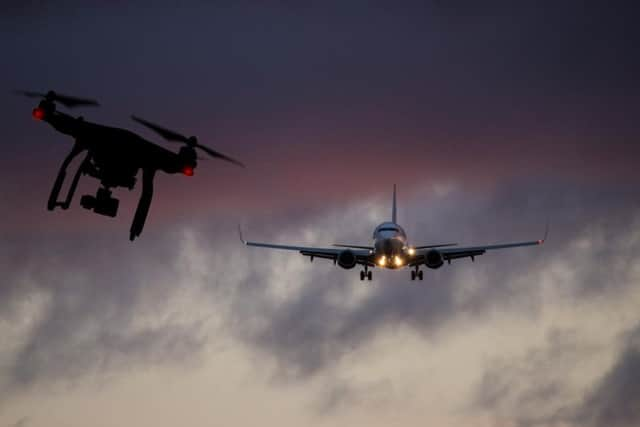

Advertisement
Hide AdAdvertisement
Hide AdThe second incident in Northumberland involved a 35-seater EMB135 plane, which was approaching Newcastle Airport at about 2,500ft above the North Sea, just north of Seaton Sluice, on February 16, 2016, when the pilot reported an unidentified object ‘about 200ft over their heads’.
The report says it was ‘black beneath and red on top, was disc-shaped and the size of large gull. It seemed to be moving with the wind away from the shore.’
While the Airprox Board couldn’t discount the object might have been a balloon, it thought the estimated size and appearance of the object made it more likely to have been a drone.
But in perhaps the most concerning incident – listed as a category B major incident – a B777 aircraft taking off from Newcastle International Airport noticed an object which the crew initially thought to be a large black bird.
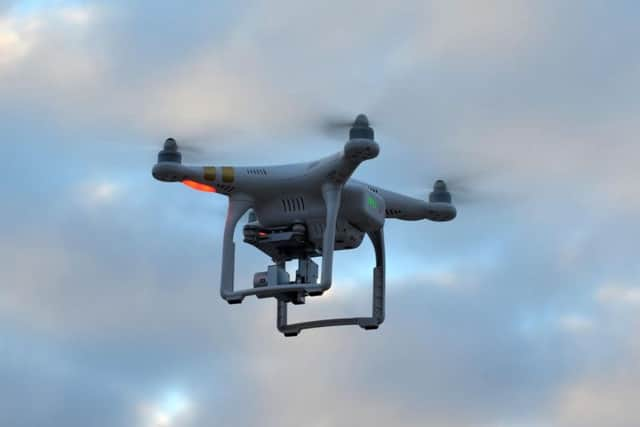

Advertisement
Hide AdAdvertisement
Hide AdUpon closing in, the crew identified it as a drone, but it was too late to avoid it and the drone passed just under the nose of the aircraft.
An investigation report said the incident – which took place near Backworth, four nautical miles from the airport – saw the drone pass just 100ft from the commercial airliner, which can seat up to 396 passengers.
The aircraft was at an altitude of 4,000ft at the time of the near-miss, which happened on August 27, 2016.
Airprox said the drone had been operating at a height above that allowed by regulation.
Advertisement
Hide AdAdvertisement
Hide AdThe board agreed the drone had been flown into conflict with the B777, causing a situation where safety had been ‘much reduced below the norm’.
Drone sightings brought 36 hours of chaos to Gatwick Airport in the run-up to Christmas, with runways closed and 1,000 flights affected in what police described as a ‘deliberate act’ of disruption.
Heathrow was also forced to ground flights after drone sightings in early January.
But pilots had begun to report narrowly missing drones in the sky from 2010 onwards, analysis of hundreds of official reports shows.
Advertisement
Hide AdAdvertisement
Hide AdSince the shutdowns, the Government has faced criticism that the events were foreseeable and more should have been done to prevent them.
But the Department for Transport has said there are already laws against such malicious acts.
Aviation Minister, Baroness Sugg, said: “The actions of these drone users were not only irresponsible, but illegal. The law could not be clearer that this is a criminal offence and anyone endangering others in this way faces imprisonment. “Airports have measures in place to counter this threat. The Government is also increasing police powers to clamp down on drone misuse, and extending no-fly zones around airports to ensure our skies are safe.”
Two-thirds of the near-collisions seen in the UK so far involved commercial passenger flights, with drones frequently being flown above regulatory height limits or within restricted airport zones.
Advertisement
Hide AdAdvertisement
Hide AdIrresponsible drone operators are rarely tracked down, the UK Airprox (Aircraft Proximity) Board documents show.
The board, which examines near-misses, noted in one report that ‘the short battery life of drones means that, with a typical flying time of approximately 15 minutes, it is difficult for the police to respond and catch drone operators flouting the regulations’.
On July 30, 2018, it became illegal for any drone to fly above 400ft.
Despite this, more than 20 near-misses above this height have been reported since the law took effect, demonstrating the difficulty in bringing irresponsible drone users to justice.
Advertisement
Hide AdAdvertisement
Hide AdThere is precedent for drones being deliberately flown near aircraft, the reports show. In 2015, an unknown person hovered a drone over the centre line of Gatwick’s runway, apparently to obtain camera footage. The drone nearly collided with a passenger plane coming in to land, but the operator was never caught by police.
The same year, a paraglider in Derbyshire reported his concerns after a drone deliberately followed him in flight. The UK Airprox Board said the ‘paraglider pilot had been placed in great peril by the reckless actions’ of the drone pilot, who had been committing a criminal offence but could not be traced.
Analysis of UK Airprox Board reports also reveals:
l Nearly three-quarters of near-misses between drones and aircraft happened in controlled airspace, such as around airports
l The highest reported sighting of a drone by a pilot was at 15,500ft, nearly 40 times the legal maximum. It came within 100ft of an Airbus 321 which had left from Doncaster Sheffield Airport on June 3, 2018
Advertisement
Hide AdAdvertisement
Hide Adl While many near-misses happen around the busy airspace of London and the South East, reports have now been logged in every region of the UK
l July is the most common month for near-misses and Sunday the most common day, perhaps a reflection of the number of hobbyists flying drones on warm summer weekends
l The UK Airprox Board is funded by the Civil Aviation Authority (CAA) and the UK Military Aviation Authority.
Jonathan Nicholson, of the CAA, said there was ‘no debate’ about the fact air travel remained the safest mode of transport but the authority wanted to remove any risk of conflict in the air.
Advertisement
Hide AdAdvertisement
Hide AdHe said: “There are some very clear reports from pilots where often drones have been flown well above 400ft. That is totally unacceptable and should not happen.
“We are very clear, the rules are very clear and people should know the rules.”
Drones have grown rapidly in popularity in recent years and can now be bought for less than £20 on the high street.
But they can also pose serious hazards to aircraft.
A strike by a drone could break an aircraft’s windscreen or cause serious damage if sucked into jet engines, propellers or helicopter rotor blades, Government officials have warned.
Advertisement
Hide AdAdvertisement
Hide AdThere have not yet been any collisions between drones and aircraft in the UK, although at least seven such incidents have been logged worldwide.
Drones and the law
Laws around the use of drones are becoming increasingly tight as the devices gain in popularity and near-misses with aircraft become more frequent.
Anyone flying a small drone must always have direct visual contact with it. Breaking this law could lead to a fine of £2,500.
On July 30, 2018, it also became against the law to fly a drone above 400ft (120m) or within 1km of an airport or airfield boundary.
Anyone caught doing so could a face a £2,500 fine.
Advertisement
Hide AdAdvertisement
Hide AdFrom November 30, 2019, all owners of drones weighing 250g or more will also have to register with the Civil Aviation Authority and drone pilots will have to take an online safety test.
Failure to comply could see people fined £1,000.
General aviation rules also apply to drone pilots.
Flying drones in a manner which is likely to endanger an aircraft could result in a five year prison sentence, as could causing an aircraft to endanger people or property.
And intentionally using a drone to commit an act of violence at an international airport could mean life imprisonment.
In January 2019, the Government announced it would be bringing forward a draft Drones Bill which could give the police powers to issue on-the-spot fines for minor drone offences.
Advertisement
Hide AdAdvertisement
Hide AdThe Government also plans to widen the restrictions around airports to about 5km.
Of course, laws could be ineffective against those who seek to cause deliberate disruption - or even danger - to flights.
So the Home Office has said it is also pushing forward with the testing and evaluation of technology to detect and combat the malicious and illegal use of drones to protect airports and other sensitive national infrastructure.
Q&A: Jonathan Nicholson, Assistant Director of Communications at the Civil Aviation Authority
Advertisement
Hide AdAdvertisement
Hide AdAre you concerned about the number of near-misses involving drones?
“Any misuse of drones is absolutely unacceptable. We have always said that. That has been a constant message we have given to drone users: they must abide by the rules and they must abide by the Drone Code. It is very easy to abide by. It is not placing severe restrictions on them. If you do operate a drone, it should be very simple to comply with the rules.”
Some Airprox reports show drones reaching some extraordinary heights. What is happening here?
“If you look at the drone forums, there is a huge disagreement between various elements of drone users and the aviation community about what is actually possible. So a lot of drone users would say getting a consumer-style drone up to those kinds of altitudes is impossible. Others say it isn’t. Certainly, some of the very high reports we get, it does sometimes perhaps call into question what has happened, in comparison to what we know is actually possible with a drone.”
Advertisement
Hide AdAdvertisement
Hide Ad“There are some very clear reports from pilots where often drones have been flown well above 400ft. That is totally unacceptable and should not happen. We are very clear, the rules are very clear and people should know the rules.”
How have you been warning about the dangers of drone misuse?
“We have an ongoing, extensive education programme for drone users that has been running for nearly three years now and have put a lot of effort into that. Commercial drone users go on a course and get education on the rules and regulations of exactly what they should do. For consumer users it is about education. We have seen a sizeable increase in public awareness of what the rules are.”
He said CAA research shows three years ago, only 20 per cent of drone users were aware of the rules, whereas now it is above 70 per cent.
Is air travel safe as things stand?
Advertisement
Hide AdAdvertisement
Hide Ad“There is no debate about that. Air travel is the safest mode of transport and remains so and everything we do is to make sure that happens, but we also want to remove any kind of conflict in the air. We want the maximum levels of safety, so that is why it is absolutely imperative that drone users follow the Code and drone rules. It is completely unacceptable to do anything different.”
Any advice to new drone owners?
“Follow the Drone Code. It’s very easy, it’s very simple.”